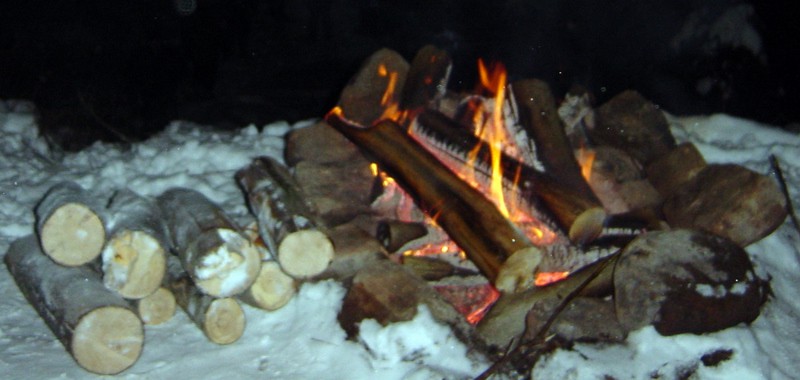Build a winter campfire using these components:
The Platform. Step 1 is paying attention to base the fire is going to sit on. Whether you are trying to promote Leave No Trace techniques and establishing a protection layer between the fire and the ground or shielding the fire from dampness or trying to keep it up out of the snow and direct it’s heat; a platform is all important. The picture below depicts a good platform. It is built in the existing fire pit at the Tirrell Pond lean-to. It has a solid base of logs; getting it up out of the snow and a couple of reflective walls to channel the heat back to the fire and towards the lean-to. Len the Fire Master preaches “Get It Off The Ground”, especially if it is damp and/or cold.
Firestarter. Whether you use matches, butane lighters, flint and steel, or decide to rub two sticks together, you need a flame or spark and something to catch fire. There are commercial materials such as wetfire or esbit tablets, homemade starters such as cotton balls dipped in Vaseline, or wax and shavings cupcakes, or nature materials such as birch bark.
Tinder. Tinder should be bone-dry, snappable twigs, about as long as your hand. You need two complete handfuls.
Kindling. Kindling should be as thick as your thumb, long as your forearm, breakable with two hands. You need at least two armfuls.
Fuel wood — anything thick and long enough that it can’t be broken by hand. It’s okay if it’s slightly damp. You need a knee-high stack.
The Process.
Step 1: Light the tinder, turning the pile gently to get air underneath it.
Step 2: Feed the kindling into the emergent fire with some pace.
Step 3: Lay on the fuel wood. Pyramid, the log cabin, whatever — the idea is to create some kind of structure so that plenty of air gets to the fire.
Fire making tips.
1. Don’t build a fire under snow-laden branches (to avoid a flame-smothering avalanche).
2. Make a foundation for your fire with medium-size logs or thick bark, or dig down to the frozen earth. Without these precautions the fire will melt into the snow and suffocate.
3. Gather only dead wood from downed trees and branches to feed your fire. If the available fuel is snow-covered and damp, use more tinder and kindling, and start with a smaller fire. “If you keep at it,” explains Kostoss, “you can dry out any wood enough to burn.”
4. For a no-hassle fire, use the classic tepee method: In the middle of your foundation, sandwich a handful of loose tinder between two layers of kindling. Prop small and medium sticks, no bigger than your wrist, upright around the kindling, their tops meeting like the poles of a tepee. Leave a larger opening on the windward side to ensure enough air for the fire, and light the tinder.
Maintenance and feeding
Pre-heat and dry larger pieces of wood by laying them discretely alongside the fire before placing them in the fire to burn. If you keep at it you can dry out any wood enough to burn.
Finally, fires by committee are notoriously problematic. Everyone has a different thermostat and style. Our process is to appoint someone as “The FireMaster” and request the FireMaster for more or less heat.

